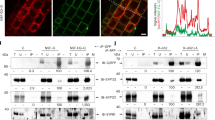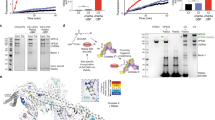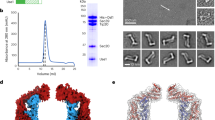Abstract
Intracellular membrane fusion proceeds via distinct stages of membrane docking, hemifusion and fusion pore opening and depends on interacting families of Rab, SNARE and SM proteins. Trans-SNARE complexes dock the membranes in close apposition. Efficient fusion requires further SNARE-associated proteins. They might increase the number of trans-SNARE complexes or the fusogenic potential of a single SNARE complex. We investigated the contributions of the SM protein Vps33 to hemifusion and pore opening between yeast vacuoles. Mutations in Vps33 that weaken its interactions with the SNARE complex allowed normal trans-SNARE pairing and lipid mixing but retarded content mixing. Deleting the Habc domain of the vacuolar t-SNARE Vam3, which interacts with Vps33, had the same effect. This suggests that SM proteins promote fusion pore opening by enhancing the fusogenic activity of a SNARE complex. They should thus be considered integral parts of the fusion machinery.
This is a preview of subscription content, access via your institution
Access options
Subscribe to this journal
Receive 12 print issues and online access
$189.00 per year
only $15.75 per issue
Buy this article
- Purchase on Springer Link
- Instant access to full article PDF
Prices may be subject to local taxes which are calculated during checkout







Similar content being viewed by others
References
Reese, C., Heise, F. & Mayer, A. Trans-SNARE pairing can precede a hemifusion intermediate in intracellular membrane fusion. Nature 436, 410–414 (2005).
Xu, Y., Zhang, F., Su, Z., McNew, J.A. & Shin, Y.K. Hemifusion in SNARE-mediated membrane fusion. Nat. Struct. Mol. Biol. 12, 417–422 (2005).
Cohen, F.S. & Melikyan, G.B. The energetics of membrane fusion from binding, through hemifusion, pore formation, and pore enlargement. J. Membr. Biol. 199, 1–14 (2004).
Chernomordik, L.V., Zimmerberg, J. & Kozlov, M.M. Membranes of the world unite! J. Cell Biol. 175, 201–207 (2006).
Chen, X. et al. SNARE-mediated lipid mixing depends on the physical state of the vesicles. Biophys. J. 90, 2062–2074 (2006).
Dennison, S.M., Bowen, M.E., Brunger, A.T. & Lentz, B.R. Neuronal SNAREs do not trigger fusion between synthetic membranes but do promote PEG-mediated membrane fusion. Biophys. J. 90, 1661–1675 (2006).
Tucker, W.C., Weber, T. & Chapman, E. Reconstitution of Ca2+-regulated membrane fusion by synaptotagmin and SNAREs. Science 304, 435–438 (2004).
Mima, J., Hickey, C.M., Xu, H., Jun, Y. & Wickner, W. Reconstituted membrane fusion requires regulatory lipids, SNAREs and synergistic SNARE chaperones. EMBO J. 27, 2031–2042 (2008).
Ohya, T. et al. Reconstitution of Rab- and SNARE-dependent membrane fusion by synthetic endosomes. Nature 459, 1091–1097 (2009).
Hua, Y. & Scheller, R.H. Three SNARE complexes cooperate to mediate membrane fusion. Proc. Natl. Acad. Sci. USA 98, 8065–8070 (2001).
Lu, X., Zhang, Y. & Shin, Y.K. Supramolecular SNARE assembly precedes hemifusion in SNARE-mediated membrane fusion. Nat. Struct. Mol. Biol. 15, 700–706 (2008).
Schwartz, M.L. & Merz, A.J. Capture and release of partially zipped trans-SNARE complexes on intact organelles. J. Cell Biol. 185, 535–549 (2009).
Rizo, J., Chen, X. & Arac, D. Unraveling the mechanisms of synaptotagmin and SNARE function in neurotransmitter release. Trends Cell Biol. 16, 339–350 (2006).
Jackson, M.B. & Chapman, E.R. The fusion pores of Ca2+-triggered exocytosis. Nat. Struct. Mol. Biol. 15, 684–689 (2008).
Shen, J., Tareste, D.C., Paumet, F., Rothman, J.E. & Melia, T.J. Selective activation of cognate SNAREpins by Sec1/Munc18 proteins. Cell 128, 183–195 (2007).
Sudhof, T.C. & Rothman, J.E. Membrane fusion: grappling with SNARE and SM proteins. Science 323, 474–477 (2009).
Dulubova, I. et al. A conformational switch in syntaxin during exocytosis: role of munc18. EMBO J. 18, 4372–4382 (1999).
Misura, K.M., Scheller, R.H. & Weis, W.I. Three-dimensional structure of the neuronal-Sec1-syntaxin 1a complex. Nature 404, 355–362 (2000).
Carr, C.M., Grote, E., Munson, M., Hughson, F.M. & Novick, P.J. Sec1p binds to SNARE complexes and concentrates at sites of secretion. J. Cell Biol. 146, 333–344 (1999).
Peng, R. & Gallwitz, D. Sly1 protein bound to Golgi syntaxin Sed5p allows assembly and contributes to specificity of SNARE fusion complexes. J. Cell Biol. 157, 645–655 (2002).
Collins, K.M., Thorngren, N.L., Fratti, R.A. & Wickner, W.T. Sec17p and HOPS, in distinct SNARE complexes, mediate SNARE complex disruption or assembly for fusion. EMBO J. 24, 1775–1786 (2005).
Rodkey, T.L., Liu, S., Barry, M. & McNew, J.A. Munc18a scaffolds SNARE assembly to promote membrane fusion. Mol. Biol. Cell 19, 5422–5434 (2008).
Sato, T.K., Rehling, P., Peterson, M.R., Emr, S.D. & Class, C. Vps protein complex regulates vacuolar SNARE pairing and is required for vesicle docking/fusion. Mol. Cell 6, 661–671 (2000).
Darsow, T., Rieder, S.E. & Emr, S.D. A multispecificity syntaxin homologue, Vam3p, essential for autophagic and biosynthetic protein transport to the vacuole. J. Cell Biol. 138, 517–529 (1997).
Dulubova, I., Yamaguchi, T., Wang, Y., Sudhof, T.C. & Rizo, J. Vam3p structure reveals conserved and divergent properties of syntaxins. Nat. Struct. Biol. 8, 258–264 (2001).
Laage, R. & Ungermann, C. The N-terminal domain of the t-SNARE Vam3p coordinates priming and docking in yeast vacuole fusion. Mol. Biol. Cell 12, 3375–3385 (2001).
Mayer, A. & Wickner, W. Docking of yeast vacuoles is catalyzed by the Ras-like GTPase Ypt7p after symmetric priming by Sec18p (NSF). J. Cell Biol. 136, 307–317 (1997).
Ostrowicz, C.W., Meiringer, C.T. & Ungermann, C. Yeast vacuole fusion: a model system for eukaryotic endomembrane dynamics. Autophagy 4, 5–19 (2008).
Reese, C. & Mayer, A. Transition from hemifusion to pore opening is rate limiting for vacuole membrane fusion. J. Cell Biol. 171, 981–990 (2005).
Collins, K.M. & Wickner, W.T. Trans-SNARE complex assembly and yeast vacuole membrane fusion. Proc. Natl. Acad. Sci. USA 104, 8755–8760 (2007).
Seals, D.F., Eitzen, G., Margolis, N., Wickner, W.T. & Price, A.A. Ypt/Rab effector complex containing the Sec1 homolog Vps33p is required for homotypic vacuole fusion. Proc. Natl. Acad. Sci. USA 97, 9402–9407 (2000).
Thorngren, N., Collins, K.M., Fratti, R.A., Wickner, W. & Merz, A.J. A soluble SNARE drives rapid docking, bypassing ATP and Sec17/18p for vacuole fusion. EMBO J. 23, 2765–2776 (2004).
Deak, F. et al. Munc18–1 binding to the neuronal SNARE complex controls synaptic vesicle priming. J. Cell Biol. 184, 751–764 (2009).
Tareste, D., Shen, J., Melia, T.J. & Rothman, J.E. SNAREpin/Munc18 promotes adhesion and fusion of large vesicles to giant membranes. Proc. Natl. Acad. Sci. USA 105, 2380–2385 (2008).
Furgason, M.L. et al. The N-terminal peptide of the syntaxin Tlg2p modulates binding of its closed conformation to Vps45p. Proc. Natl. Acad. Sci. USA 106, 14303–14308 (2009).
Dulubova, I. et al. How Tlg2p/syntaxin 16 'snares' Vps45. EMBO J. 21, 3620–3631 (2002).
Bracher, A. & Weissenhorn, W. Structural basis for the Golgi membrane recruitment of Sly1p by Sed5p. EMBO J. 21, 6114–6124 (2002).
Wiederkehr, A., De Craene, J.O., Ferro-Novick, S. & Novick, P. Functional specialization within a vesicle tethering complex: bypass of a subset of exocyst deletion mutants by Sec1p or Sec4p. J. Cell Biol. 167, 875–887 (2004).
Gulyas-Kovacs, A. et al. Munc18–1: sequential interactions with the fusion machinery stimulate vesicle docking and priming. J. Neurosci. 27, 8676–8686 (2007).
Johnson, J.R. et al. Binding of UNC-18 to the N-terminus of syntaxin is essential for neurotransmission in Caenorhabditis elegans. Biochem. J. 418, 73–80 (2009).
Weimer, R.M. et al. Defects in synaptic vesicle docking in unc-18 mutants. Nat. Neurosci. 6, 1023–1030 (2003).
Gerber, S.H. et al. Conformational switch of syntaxin-1 controls synaptic vesicle fusion. Science 321, 1507–1510 (2008).
de Wit, H. et al. Synaptotagmin-1 docks secretory vesicles to syntaxin-1/SNAP-25 acceptor complexes. Cell 138, 935–946 (2009).
Khvotchev, M. et al. Dual modes of Munc18–1/SNARE interactions are coupled by functionally critical binding to syntaxin-1 N terminus. J. Neurosci. 27, 12147–12155 (2007).
Fisher, R.J., Pevsner, J. & Burgoyne, R.D. Control of fusion pore dynamics during exocytosis by Munc18. Science 291, 875–878 (2001).
Schütz, D., Zilly, F., Lang, T., Jahn, R. & Bruns, D. A dual function for Munc-18 in exocytosis of PC12 cells. Eur. J. Neurosci. 21, 2419–2432 (2005).
Barclay, J.W., Aldea, M., Craig, T.J., Morgan, A. & Burgoyne, R.D. Regulation of the fusion pore conductance during exocytosis by cyclin-dependent kinase 5. J. Biol. Chem. 279, 41495–41503 (2004).
Boyd, A. et al. A random mutagenesis approach to isolate dominant-negative yeast sec1 mutants reveals a functional role for domain 3a in yeast and mammalian Sec1/Munc18 proteins. Genetics 180, 165–178 (2008).
Bowen, M.E., Weninger, K., Brunger, A.T. & Chu, S. Single molecule observation of liposome-bilayer fusion thermally induced by soluble N-ethyl maleimide sensitive-factor attachment protein receptors (SNAREs). Biophys. J. 87, 3569–3584 (2004).
Dietrich, L.E. et al. ATP-independent control of Vac8 palmitoylation by a SNARE subcomplex on yeast vacuoles. J. Biol. Chem. 280, 15348–15355 (2005).
Munson, M. & Bryant, N.J. A role for the syntaxin N-terminus. Biochem. J. 418, e1–e3 (2009).
Carpp, L.N., Ciufo, L.F., Shanks, S.G., Boyd, A. & Bryant, N.J. The Sec1p/Munc18 protein Vps45p binds its cognate SNARE proteins via two distinct modes. J. Cell Biol. 173, 927–936 (2006).
Van Komen, J.S., Bai, X., Scott, B.L. & McNew, J.A. An intramolecular t-SNARE complex functions in vivo without the syntaxin NH2-terminal regulatory domain. J. Cell Biol. 172, 295–307 (2006).
Biederer, T. & Sudhof, T.C. Mints as adaptors. Direct binding to neurexins and recruitment of munc18. J. Biol. Chem. 275, 39803–39806 (2000).
Kraynack, B.A. et al. Dsl1p, Tip20p, and the novel Dsl3(Sec39) protein are required for the stability of the Q/t-SNARE complex at the endoplasmic reticulum in yeast. Mol. Biol. Cell 16, 3963–3977 (2005).
Peterson, M.R., Burd, C.G. & Emr, S.D. Vac1p coordinates Rab and phosphatidylinositol 3-kinase signaling in Vps45p-dependent vesicle docking/fusion at the endosome. Curr. Biol. 9, 159–162 (1999).
Neupert, W. & Brunner, M. The protein import motor of mitochondria. Nat. Rev. Mol. Cell Biol. 3, 555–565 (2002).
McNew, J.A., Weber, T., Engelman, D.M., Sollner, T.H. & Rothman, J.E. The length of the flexible SNAREpin juxtamembrane region is a critical determinant of SNARE-dependent fusion. Mol. Cell 4, 415–421 (1999).
Kesavan, J., Borisovska, M. & Bruns, D. v-SNARE actions during Ca2+-triggered exocytosis. Cell 131, 351–363 (2007).
Langosch, D., Hofmann, M. & Ungermann, C. The role of transmembrane domains in membrane fusion. Cell. Mol. Life Sci. 64, 850–864 (2007).
Acknowledgements
We thank S. Emr (Weill Institute for Cell and Molecular Biology) for strains and plasmids and V. Comte and M. Reinhardt for assistance. This work was supported by grants from the Swiss National Science Foundation, the Roche Research Foundation, the Human Frontier Science Program and the Leenaards Foundation.
Author information
Authors and Affiliations
Contributions
M.P. and A.S. performed the experiments; M.P. and A.M. designed the experiments and wrote the paper.
Corresponding author
Ethics declarations
Competing interests
The authors declare no competing financial interests.
Supplementary information
Supplementary Text and Figures
Supplementary Figures 1–8, Supplementary Tables 1 and 2 and Supplementary Methods (PDF 1246 kb)
Rights and permissions
About this article
Cite this article
Pieren, M., Schmidt, A. & Mayer, A. The SM protein Vps33 and the t-SNARE Habc domain promote fusion pore opening. Nat Struct Mol Biol 17, 710–717 (2010). https://doi.org/10.1038/nsmb.1809
Received:
Accepted:
Published:
Issue Date:
DOI: https://doi.org/10.1038/nsmb.1809
This article is cited by
-
Vesicle trafficking and vesicle fusion: mechanisms, biological functions, and their implications for potential disease therapy
Molecular Biomedicine (2022)
-
A tethering complex drives the terminal stage of SNARE-dependent membrane fusion
Nature (2017)
-
A modular tethering complex for endosomal recycling
Nature Cell Biology (2015)
-
Dynamin−SNARE interactions control trans-SNARE formation in intracellular membrane fusion
Nature Communications (2013)
-
Munc18-1 mutations that strongly impair SNARE-complex binding support normal synaptic transmission
The EMBO Journal (2012)



